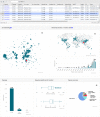PLSDB: a resource of complete bacterial plasmids
- PMID: 30380090
- PMCID: PMC6323999
- DOI: 10.1093/nar/gky1050
PLSDB: a resource of complete bacterial plasmids
Abstract
The study of bacterial isolates or communities requires the analysis of the therein included plasmids in order to provide an extensive characterization of the organisms. Plasmids harboring resistance and virulence factors are of especial interest as they contribute to the dissemination of antibiotic resistance. As the number of newly sequenced bacterial genomes is growing a comprehensive resource is required which will allow to browse and filter the available plasmids, and to perform sequence analyses. Here, we present PLSDB, a resource containing 13 789 plasmid records collected from the NCBI nucleotide database. The web server provides an interactive view of all obtained plasmids with additional meta information such as sequence characteristics, sample-related information and taxonomy. Moreover, nucleotide sequence data can be uploaded to search for short nucleotide sequences (e.g. specific genes) in the plasmids, to compare a given plasmid to the records in the collection or to determine whether a sample contains one or multiple of the known plasmids (containment analysis). The resource is freely accessible under https://ccb-microbe.cs.uni-saarland.de/plsdb/.
Figures


Similar articles
-
PLSDB: advancing a comprehensive database of bacterial plasmids.Nucleic Acids Res. 2022 Jan 7;50(D1):D273-D278. doi: 10.1093/nar/gkab1111. Nucleic Acids Res. 2022. PMID: 34850116 Free PMC article.
-
The PLSDB 2025 update: enhanced annotations and improved functionality for comprehensive plasmid research.Nucleic Acids Res. 2025 Jan 6;53(D1):D189-D196. doi: 10.1093/nar/gkae1095. Nucleic Acids Res. 2025. PMID: 39565221 Free PMC article.
-
Plasmid ATLAS: plasmid visual analytics and identification in high-throughput sequencing data.Nucleic Acids Res. 2019 Jan 8;47(D1):D188-D194. doi: 10.1093/nar/gky1073. Nucleic Acids Res. 2019. PMID: 30395323 Free PMC article.
-
WeFaceNano: a user-friendly pipeline for complete ONT sequence assembly and detection of antibiotic resistance in multi-plasmid bacterial isolates.BMC Microbiol. 2021 Jun 7;21(1):171. doi: 10.1186/s12866-021-02225-y. BMC Microbiol. 2021. PMID: 34098864 Free PMC article.
-
Insights into the Potential Role of Plasmids in the Versatility of the Genus Pantoea.Mol Biotechnol. 2024 Dec;66(12):3398-3414. doi: 10.1007/s12033-023-00960-3. Epub 2023 Nov 26. Mol Biotechnol. 2024. PMID: 38007817 Review.
Cited by
-
Characterisation of Phage Susceptibility Variation in Salmonellaenterica Serovar Typhimurium DT104 and DT104b.Microorganisms. 2021 Apr 17;9(4):865. doi: 10.3390/microorganisms9040865. Microorganisms. 2021. PMID: 33920555 Free PMC article.
-
Colonization of a hand washing sink in a veterinary hospital by an Enterobacter hormaechei strain carrying multiple resistances to high importance antimicrobials.Antimicrob Resist Infect Control. 2020 Oct 21;9(1):163. doi: 10.1186/s13756-020-00828-0. Antimicrob Resist Infect Control. 2020. PMID: 33087168 Free PMC article.
-
Reconsidering plasmid maintenance factors for computational plasmid design.Comput Struct Biotechnol J. 2018 Dec 15;17:70-81. doi: 10.1016/j.csbj.2018.12.001. eCollection 2019. Comput Struct Biotechnol J. 2018. PMID: 30619542 Free PMC article. Review.
-
Plasmids of the urinary microbiota.Access Microbiol. 2022 Nov 30;4(11):acmi000429. doi: 10.1099/acmi.0.000429. eCollection 2022. Access Microbiol. 2022. PMID: 36644432 Free PMC article.
-
The 26th annual Nucleic Acids Research database issue and Molecular Biology Database Collection.Nucleic Acids Res. 2019 Jan 8;47(D1):D1-D7. doi: 10.1093/nar/gky1267. Nucleic Acids Res. 2019. PMID: 30626175 Free PMC article.
References
-
- Rozwandowicz M., Brouwer M.S.M., Fischer J., Wagenaar J.A., Gonzalez-Zorn B., Guerra B., Mevius D.J., Hordijk J.. Plasmids carrying antimicrobial resistance genes in Enterobacteriaceae. J. Antimicrob. Chemother. 2018; 73:1121–1137. - PubMed
-
- Liu Y.Y., Wang Y., Walsh T.R., Yi L.X., Zhang R., Spencer J., Doi Y., Tian G., Dong B., Huang X. et al. .. Emergence of plasmid-mediated colistin resistance mechanism MCR-1 in animals and human beings in China: a microbiological and molecular biological study. Lancet Infect. Dis. 2016; 16:161–168. - PubMed
-
- Orlek A., Phan H., Sheppard A.E., Doumith M., Ellington M., Peto T., Crook D., Walker A.S., Woodford N., Anjum M.F., Stoesser N.. Ordering the mob: Insights into replicon and MOB typing schemes from analysis of a curated dataset of publicly available plasmids. Plasmid. 2017; 91:42–52. - PMC - PubMed
Publication types
MeSH terms
Substances
LinkOut - more resources
Full Text Sources
Other Literature Sources
Research Materials

